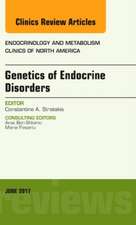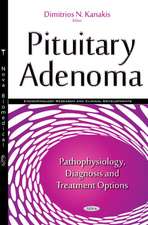Gigantism and Acromegaly
Editat de Constantine A. Stratakisen Limba Engleză Paperback – 9 iun 2021
Acromegaly is a rare pituitary disorder that slowly changes its adult victim’s appearance over time: larger hands and feet, bigger jaw, forehead, nose, and lips. Generally, a benign pituitary tumor is the cause and symptoms of acromegaly can vary from patient to patient, making a diagnosis difficult and prolonging suffering for years. Early detection is key in the management of acromegaly as the pathologic effects of increased growth hormone (GH) production are progressive and can be life-threatening as the result of associated cardiovascular, cerebrovascular, and respiratory disorders and malignancies.
- Accessible, up-to-date overview of the characteristics, state-of-the-art diagnostic procedures, and management of acromegaly and gigantism
- Provides a unique compendium of endocrinology, genetics, clinical diagnosis and therapeutics
- Contains contributions from internationally known experts who have treated patients with acromegaly and gigantism
Preț: 476.63 lei
Nou
Puncte Express: 715
Preț estimativ în valută:
91.24€ • 93.84$ • 75.70£
91.24€ • 93.84$ • 75.70£
Carte disponibilă
Livrare economică 29 ianuarie-12 februarie
Livrare express 14-18 ianuarie pentru 38.93 lei
Preluare comenzi: 021 569.72.76
Specificații
ISBN-13: 9780128145371
ISBN-10: 0128145374
Pagini: 310
Dimensiuni: 191 x 235 x 25 mm
Greutate: 0.54 kg
Editura: ELSEVIER SCIENCE
ISBN-10: 0128145374
Pagini: 310
Dimensiuni: 191 x 235 x 25 mm
Greutate: 0.54 kg
Editura: ELSEVIER SCIENCE
Public țintă
Endocrinologists with interest in pituitary tumors resulting in acromegaly and gigantism, pediatric endocrinologists and clinical geneticists, medical students and fellows.Cuprins
1. History of the identification of gigantism and acromegaly Liliya Rostomyan, Albert Beckers and Patrick Petrossians 2. Pathology of pituitary growth hormone excess Sylvia L. Asa and Shereen Ezzat 3. Gigantism: clinical diagnosis and description, Iulia Potorac Liliya Rostomyan, Adrian F. Daly, Patrick Petrossians and Albert Beckers 4. Acromegaly: clinical description and diagnosis Kevin C.J. Yuen and Albert Becker 5. GPR101, an orphan G-protein coupled receptor, with roles in growth, puberty, and possibly appetite regulation Fady Hannah-Shmouni and Constantine A. Stratakis 6. The role of the aryl hydrocarbon receptor interacting protein in pituitary tumorigenesis Laura C. Herna´ndez-Ramı´rez 7. The 3PAs syndrome and succinate dehydrogenase deficiency in pituitary tumors Paraskevi Xekouki, Vasiliki Daraki, Grigoria Betsi, Maria Chrysoulaki, Maria Sfakiotaki, Maria Mytilinaiou and Constantine A. Stratakis 8. CDKN1B (p27) defects leading to pituitary tumors Sebastian Gulde and Natalia S. Pellegata 9. Multiple endocrine neoplasia syndromes and somatotroph adenomas Carolina R.C. Pieterman and Steven G. Waguespack 10. GNAS, McCuneErika Peverelli, Donatella Treppiedi, Federica Mangili Rosa Catalano and Giovanna Mantovani 11. Surgical management of growth hormone-secreting adenomas Elizabeth Hogan and Prashant Chittiboina 12. Medical management of pituitary gigantism and acromegaly Adrian F. Daly and Albert Beckers 13. GHRH-producing tumors and other neuroendocrine neoplasms associated with acromegaly and/or gigantism Sara Pakbaz, Anjelica Hodgson and Ozgur Mete 14. Increased growth hormone secretion from lesions outside the anterior pituitary Christina Tatsi and Constantine A. Stratakis


























